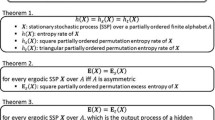Abstract
Transfer entropy is a measure of the magnitude and the direction of information flow between jointly distributed stochastic processes. In recent years, its permutation analogues are considered in the literature to estimate the transfer entropy by counting the number of occurrences of orderings of values, not the values themselves. It has been suggested that the method of permutation is easy to implement, computationally low cost and robust to noise when applying to real world time series data. In this paper, we initiate a theoretical treatment of the corresponding rates. In particular, we consider the transfer entropy rate and its permutation analogue, the symbolic transfer entropy rate, and show that they are equal for any bivariate finite-alphabet stationary ergodic Markov process. This result is an illustration of the duality method introduced in [T. Haruna, K. Nakajima, Physica D 240, 1370 (2011)]. We also discuss the relationship among the transfer entropy rate, the time-delayed mutual information rate and their permutation analogues.
Similar content being viewed by others
References
T. Schreiber, Phys. Rev. Lett. 85, 461 (2000)
M. Besserve, B. Schoelkopf, N.K. Logothetis, S. Panzeri, J. Comput. Neurosci. 29, 547 (2010)
A. Buehlmann, G. Deco, PLoS Comput. Biol. 6, e1000934 (2010)
M. Garofalo, T. Nieus, P. Massobrio, S. Martinoia, PLoS ONE 4, e6482 (2009)
C.J. Honey, R. Koetter, M. Breakspear, O. Sporns, Proc. Natl. Acad. Sci. USA 104, 10240 (2007)
T. Katura, N. Tanaka, A. Obata, H. Sato, A. Maki, Neuroimage 31, 1592 (2006)
N. Luedtke, N.K. Logothetis, S. Panzeri, Magn. Reson. Imag. 28, 1113 (2010)
M. Lungarella, O. Sporns, PLoS Comput. Biol. 2, e144 (2006)
S.A. Neymotin, K.M. Jacobs, A.A. Fenton, W.W. Lytton, J. Comput. Neurosci. 30, 69 (2011)
S. Sabesan, L.B. Good, K.S. Tsakalis, A. Spanias, D.M. Treiman, L.D. Iasemidis, IEEE Trans. Neural Syst. Rehabil. Eng. 17, 244 (2009)
V.A. Vakorin, O.A. Krakovska, A.R. McIntosh, J. Neurosci. Methods 184, 152 (2009)
M. Bauer, J.W. Cox, M.H. Caveness, J.J. Downs, N.F. Thornhill, IEEE Trans. Control Syst. Technol. 15, 12 (2007)
H. Kamberaj, A. van der Vaart, Biophys. J. 97, 1747 (2009)
R. Marschinski, H. Kantz, Eur. Phys. J. B 30, 275 (2002)
M. Materassi, A. Wernik, E. Yordanova, Nonlin. Processes Geophys. 14, 153 (2007)
L.J. Moniz, E.G. Cooch, S.P. Ellner, J.D. Nichols, J.M. Nichols, Ecol. Modell. 208, 145 (2007)
J.M. Nichols, M. Seaver, S.T. Trickey, M.D. Todd, C. Olson, L. Overbey, Phys. Rev. E 72, 046217 (2005)
J. Pahle, A.K. Green, C.J. Dixon, U. Kummer, BMC Bioinf. 9, 139 (2008)
T.Q. Tung, T. Ryu, K.H. Lee, D. Lee, in Proceedings of 20th IEEE International Symposium on Computer-Based Medical Systems, edited by P. Kokol, V. Podgorelec, D. MiceticTurk, M. Zorman, M. Verlic (2007), p. 383
C. Bandt, B. Pompe, Phys. Rev. Lett. 88, 174102 (2002)
C. Bandt, G. Keller, B. Pompe, Nonlinearity 15, 1595 (2002)
C. Bandt, F. Shiha, J. Time Ser. Anal. 28, 646 (2007)
J.M. Amigó, M.B. Kennel, Physica D 231, 137 (2007)
M. Misiurewicz, Nonlinearity 16, 971 (2003)
K. Keller, M. Sinn, Physica D 239, 997 (2010)
K. Keller, A.M. Unakafov, V.A. Unakafova, Physica D 241, 1477 (2012)
J.M. Amigó, Permutation Complexity in Dynamical Systems (Springer-Verlag, Berlin, Heidelberg, 2010)
T.M. Cover, J.A. Thomas, Elements of Information Theory (John Wiley & Sons Inc., New York, 1991)
J.M. Amigó, M.B. Kennel, L. Kocarev, Physica D 210, 77 (2005)
J.M. Amigó, Physica D 241, 789 (2012)
M. Staniek, K. Lehnertz, Phys. Rev. Lett. 100, 158101 (2008)
A.M. Kowalski, M.T. Martin, A. Plastino, L. Zunino, Phys. Lett. A 374, 1819 (2010)
M. Martini, T.A. Kranz, T. Wagner, K. Lehnertz, Phys. Rev. E 83, 011919 (2011)
A. Papana, D. Kugiumtzis, P.G. Larsson, Phys. Rev. E 83, 036207 (2011)
D. Kugiumtzis, J. Nonlin. Sys. Appl. 3, 73 (2012)
P.O. Amblard, O.J.J. Michel, J. Comput. Neurosci. 30, 7 (2011)
T. Haruna, K. Nakajima, Physica D 240, 1370 (2011)
J.P. Crutchfield, N.H. Packard, Physica D 7, 201 (1983)
J.P. Crutchfield, D.P. Feldman, Chaos 15, 25 (2003)
D.P. Feldman, C.S. McTague, J.P. Crutchfield, Chaos 18, 043106 (2008)
R. Shaw, The Dripping Faucet as a Model Chaotic System (Aerial Press, Santa Cruz, 1984)
P. Grassberger, Int. J. Theor. Phys. 25, 907 (1986)
W. Bialek, I. Nemenman, N. Tishby, Neural Comput. 13, 2409 (2001)
W. Li, Complex Systems 5, 381 (1991)
D.V. Arnold, Complex Systems 10, 143 (1996)
A. Katok, B. Hasselblatt, Introduction to the Modern Theory of Dynamical Systems (Cambridge University Press, Cambridge, 1995)
A.M. Fraser, H.L. Swinney, Phys. Rev. A 33, 1134 (1986)
K. Kaneko, Physica D 23, 436 (1986)
J.A. Vastano, H.L. Swinney, Phys. Rev. Lett. 60, 1773 (1988)
Author information
Authors and Affiliations
Corresponding author
Rights and permissions
About this article
Cite this article
Haruna, T., Nakajima, K. Symbolic transfer entropy rate is equal to transfer entropy rate for bivariate finite-alphabet stationary ergodic Markov processes. Eur. Phys. J. B 86, 230 (2013). https://doi.org/10.1140/epjb/e2013-30721-4
Received:
Revised:
Published:
DOI: https://doi.org/10.1140/epjb/e2013-30721-4




